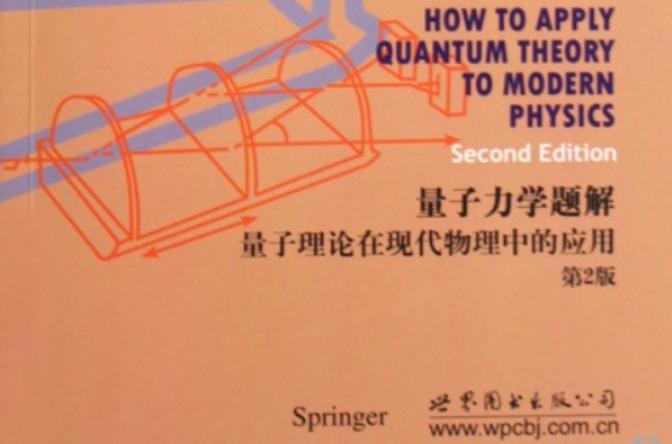《量子力學題解:量子理論在現在物理中的套用》是一本書籍,本書方式獨特地展示了量子力學基本原理在原子分子物理、凝聚態物理、光學、量子信息和量子計算等學科中的套用。書中習題與現代量子力學實驗和理論聯繫密切,部分題目有一定難度,可以深化讀者對物理概念的理解,為從事更深入的科學研究打下堅實的基礎。
基本介紹
- 書名:量子力學題解:量子理論在現在物理中的套用
- 頁數:292頁
- 出版時間:第2版 (2009年5月1日)
- 裝幀:平裝

《量子力學題解:量子理論在現在物理中的套用》是一本書籍,本書方式獨特地展示了量子力學基本原理在原子分子物理、凝聚態物理、光學、量子信息和量子計算等學科中的套用。書中習題與現代量子力學實驗和理論聯繫密切,部分題目有一定難度,可以深化讀者對物理概念的理解,為從事更深入的科學研究打下堅實的基礎。
《量子力學題解:量子理論在現在物理中的套用》是一本書籍,本書方式獨特地展示了量子力學基本原理在原子分子物理、凝聚態物理、光學、量子信息和量子計算等學科中的...
(物理學理論)編輯 鎖定 本詞條由“科普中國”百科科學詞條編寫與套用工作項目 ...的量子理論(能量一份一份的傳遞)體系上建立了薛丁格方程,從而開闢了量子力學的...
量子力學不僅是現代物理學的基礎理論之一,而且在化學等學科和許多近代技術中得到廣泛套用。 19世紀末,人們發現舊有的經典理論無法解釋微觀系統,於是經由物理學家的...
《量子力學習題與解答》是2011年科學出版社出版的圖書。該書主要匯集量子力學習題約300道,並給出詳細解答。並供報考物理相關專業的碩士研究生入學考試備考者在考前...
本詞條由“科普中國”科學百科詞條編寫與套用工作項目 審核。量子物理(量子力學 ...一個是原子層次的物質理論:量子力學;正是它我們才能理解和操縱物質世界。另一個...
《大學物理習題精解系列:量子力學習題精解》是與《量子力學》(張永德,2002.3,科學...第六章 對稱性分析及套用 第七章 電子自旋角動量 第八章 定態微擾論 第九章...
量子力學和相對論是近代物理學的兩大支柱。量子力學理論體系的自洽性及其與實驗事實的符合,已經得到學術界的公認,但是對它的基本概念的理解與解釋,也就是量子力學的...
量子力學是現代物理學的基礎,他的套用極其廣泛和成功。由於我們對原子內部電子...量子力學物理解釋包含的問題很多。這些問題包括:量子力學是否是完備的理論;如何...
本詞條由“科普中國”科學百科詞條編寫與套用工作項目 審核。量子(quantum)是現代...量子理論的發展進入了量子力學階段。1928年,英國物理學家狄拉克完成了矩陣力學和...
《相對論量子力學》是一部介紹相對論量子理論的研究生教程,重在強調其在凝聚態物理中的重要套用。基本理論包括:狹義相對論,角動量和零自旋粒子;文章討論了Dirac ...
屬於萬有理論之一隅;主要嘗試結合廣義相對論與量子力學,為當前的物理學尚未解決...由廣義相對論描述經典引力的正確性很少有人懷疑。量子引力套用範圍 ...
量子力學方法是套用量子力學理論研究微觀客體運動規律的方法。20世紀初發現的與輻射現象有關的大量實驗事實表明,運用牛頓力學已不能解釋這些現象。微觀粒子(如分子、...
量子力學的數學初步和基本假設、與時間無關問題的代數研究、中心力場、定態微擾理論、變分法、與時間有關的微擾理論——量子躍遷、幾個典型套用、彈性散射、全同...
近代以來,量子力學一直被作為物理及相關專業必修的、最重要的基礎理論課.特別是近些年來,由於技術的進步,它的套用範圍越來越廣泛.量子力學與愛因斯坦建立的相對論的一...
現在量子力學不僅是物理學中的基礎理論之一,而且在化學和許多近代技術中也得到了廣泛的套用。上世紀末和本世紀初,物理學的研究領域從巨觀世界逐漸深入到微觀世界;...
能解釋的現象,大量的實驗事實及實際套用也證明了量子力學是一個成功的物理理論。...統計解釋認為態函式是對統計系統的描述,量子理論是關於系統的統計理論,這個系統是...
1900年12月14日,普朗克在柏林的物理學會上發表了題...我們現在的文明都建立在量子理論之上。儘管量子力學...普朗克將他的量子假設套用到輻射體表面振子的能量上,...
我們著重於最基本的原理和典型的套用,精選一些有代表性的論題。並且,不收入一些在後續課程(例如固體物理學、量子統計物理學和高等量子力學)里必定要講到的內容。本...
量子力學很難套用。需要相對高級的數學技巧。即使是線性的,那基本方程仍是一個...現在唯一沒有處理得很好的物理現象就是重力;量子力學還沒有擴展到與廣義相對論...
《中國科學技術大學精品教材:量子力學基礎》是2012年中國科學技術大學出版社出版的...、提煉概念、利用合適的推理工具演繹,最終又返回物理,落實在科學和技術的套用上...
結合廣義相對論與量子力學在一起的量子引力理論,能否...量子理論的描述怎樣成為做實驗所觀查到的大自然實在...觀測到的星球繞著星系中心轉動的速度與套用牛頓力學預測...
圈量子引力的主要物理構想都以廣義相對論和量子力學為基礎, 而不附加任何額外的...傳統的微擾量子化方法在套用於引力場時遇到了不可重整化的困難, 並且難以反映...
導致量子力學理論必須引入“主觀介入”,微觀概念不再具有“客觀性”,從而量子微觀...(2)對量子描述賦予客觀的物理實在:量子態。據《自然》雜誌最近報導,現在卡爾-...
適合作為物理類研究生的公共理論基礎教材,也是物理學...進入科大以來主講過:光學、量子力學,高等量子理論,多...1.4 量子系綜與密度矩陣(Ⅲ)——信息、認證和套用...
本詞條由“科普中國”科學百科詞條編寫與套用工作項目...它以量子態為信息載體,利用量子力學的一些基本物理...首先量子通信絕對不是騙局,它只是利用量子理論進行...
至於弦理論能不能成功的解釋基於目前物理界已知的所有作用力和物質所組成的宇宙以及套用到“黑洞”、“宇宙大爆炸”等需要同時用到量子力學與廣義相對論的極端情況,...
密度泛函理論(Density functional theory ,縮寫DFT)是一種研究多電子體系電子結構的量子力學方法。密度泛函理論在物理和化學上都有廣泛的套用,特別是用來研究分子和...
是由奧地利物理學家薛丁格提出的量子力學中的一個...推導出一個相對論性波動方程,他將這方程套用於氫...就像被一個迷語困惑多時,渴慕知道答案的孩童,現在...
